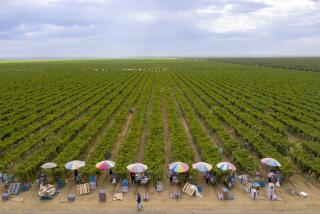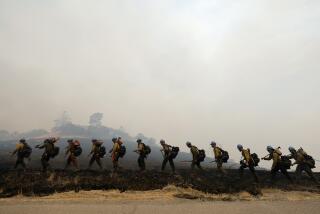Vintage Weather : Agriculture: Heat and humidity lead to early North County grape harvest, while the unusual conditions spell trouble for dairy farmers and citrus growers.
Since the Last Supper, clergymen have been known to turn to wine.
On Tuesday, winemaker Leon N. Santoro turned to the church.
Santoro asked the priest with a name that seemed to come straight from central casting, Father Barry Vinyard, to perform what will become a tradition at Thomas-Jaeger Winery in Escondido: blessing the first grape harvest of the summer.
After all, winemaking, like the rest of the agriculture industry, is more than a science or an art or a communion with nature.
“A little bit of luck doesn’t hurt,” Santoro, 41, said with a wry smile. “I’ll take all the help I can get, even divine intervention.”
This summer, Santoro’s first as wine master of the 120-acre winery, has been a freakish, humid affair for farmers all over San Diego County.
Dairy cows have keeled over from the heat, avocado and citrus fruit are dropping off the branches, even veteran farmer Ben Hillebrecht’s watermelons admittedly aren’t up to snuff this year.
The summer’s odd weather has forced Santoro’s harvest to come at least two weeks earlier than usual. He blamed it on a combination of factors, including a warm early February when the grapes began to form, followed by the heat and humidity of the summer months.
But it’s the same for winemakers all over the state, from Napa Valley south, Santoro said.
“For grapes, February is the starting gate, when the fruit starts budding and everything takes off,” said Santoro, whose thick accent reveals his upbringing in Abruzzi, Italy, northeast of Rome.
Then it becomes the winemaker’s job to know by the sugar-acid balance, the condition of the vine and the taste that the plant is ready to give up the fruit, Santoro said.
Despite the surprisingly early harvest, the humidity was tempered by heat, which works for the temperamental grape, he said.
“The humidity was accompanied by heat this summer, which is good for us,” Santoro said. “If we would have had humidity with cool weather, then we could have problems.”
However, what is good for the winemaker is not necessarily good for the dairy farmer, said David Owen, executive director of the San Diego County Farm Bureau.
The near 100-degree heat can kill the 1,500-pound animals that have no efficient method of keeping cool other than finding shade, Owen said.
In a county with 18 dairies and where milk is the 10th-largest agricultural industry worth about $20 million a year, farmers have been losing cattle and calves have been aborted, all due primarily to the summer heat. Some farmers have turned to misting the animals with a fine water spray to save them, Owen said.
“These animals are wearing thick leather jackets,” Owen said. “Then at night they tend to retain the heat. That’s how they survive blizzards. But the combination of the stress of milk production and the heat has been tough on dairy cattle.”
The minor, premature dropping of avocado and citrus is caused by a lack of water to match the heat, Owen said. Farmers who don’t turn up the water on their crops when it gets hot lose some of their fruit.
“When it’s really hot, don’t we need to drink more water or ice tea or something,” said Mike Hillebrecht, who, with his father, Ben, runs a 200-acre farm east of Escondido. “Well, plants need the same thing.”
Hillebrecht has lost some of his raspberry crop to the heat and the melons either got too hot or ripened too fast, he said.
“We’ve lost a bunch of them that are not salable,” he said.
But any loss of citrus fruit can be notable since citrus fruits demand a huge market share in the county, Owen said. Valencia oranges are ranked the No. 4 crop, lemons the sixth, and grapefruit seventh, he said.
While the county is not yet known worldwide for its vineyards, Santoro claims that is only a matter of time. After only eight months in the county, where he moved after stints at Louis Martini Winery and Stag’s Leap in Napa, Santoro is convinced this is also wine country.
San Diego County already has the heat and the Mediterranean climate; all it needs is the experimentation of generations and it will eventually match Europeans vineyards, he said. His vineyard is surrounded by an array of microclimates that most closely resembles Tuscany in Italy or St. Helena in Napa Valley.
“California has better weather than France, which is very difficult for the French to accept,” Santoro said. “We just haven’t found the right grapes for the right areas--yet. There is still so much we need to learn in California. But it is like striking gold. You put the right variety in the right soil, and boom!”


